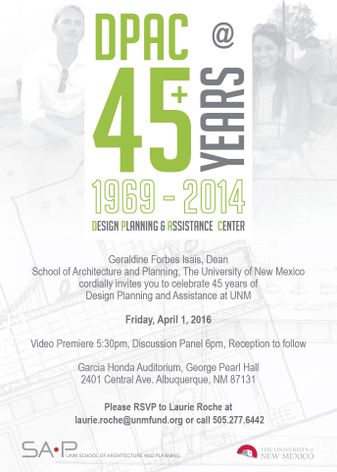UNM Design Planning Assistance Center celebrates 45+ years with video premiere
March 29, 2016 - Carolyn Gonzales
The University of New Mexico School of Architecture & Planning celebrates 45+ years of its Design Planning Assistance Center (DPAC) with a video premiere on Friday, April 1 at 5:30 p.m., followed by a panel presentation in the Garcia Honda Auditorium in George Pearl Hall, located on the UNM campus at Central and Cornell NE. The event is free and open to the public.
Panel presenters are Jamie Blosser, executive director, Santa Fe Art Institute; Fred Gifford, director, National Global Information Systems at the Trust for Public Lands; and Jessica Garz, program officer, Thriving Cultures at the Surdna Foundation.
“The School’s leadership is at a crossroads concerning the future of DPAC,” said Michaele Pride, associate dean of public outreach and engagement. “Panelists will address other models of engagement, funding options including what public agencies and private foundations are looking to support in regard to social and community engagement and their approach and impact.”
The first DPAC project was the Padilla House in 1969. The house was designed by students to assist a flood victim in the San Jose neighborhood whose home had been damaged beyond repair.

DPAC went from one house to a neighborhood, with the Martineztown Redevelopment Plan, conducted in collaboration with the Citizens’ Information Committee of Martineztown, 1971-73.
Before long, DPAC was conducting Main Street and other studio projects around the state: Artesia, Clovis, Santa Rosa, Belen, Portales, Raton, Silver City, Truth or Consequences, Mountain View and Tucumcari, to name just a few.
“Community engaged scholarship was a need and the students at the School stepped up,” said Geraldine Forbes Isais, dean, UNM School of Architecture & Planning. “That same need exists and the School still does the work and needs to double the efforts.”
She added that after Pratt Institute, DPAC is the second oldest community design center of its kind in the country.
In 2014, Pride responded to a question about the educational value of DPAC. She said, “The presence of multiple disciplines helps address multiple issues with strategies of building design, site improvement, public policy, streetscape, energy and water systems. Challenges come in the form of learning to work together, understanding and appreciating each discipline’s knowledge and skill, and last but not least, just organizing schedules and projects in the context of diverse academic curriculum requirements.”
Mark Childs, associate dean and DPAC director from 2002-06, addressed DPAC’s value in economic and social realms. He said, “Architecture is a profession. Architects are licensed, and thus given a monopoly power by the government to serve the public good in addition to their direct service to a client. This should in no way be in conflict with creating great design, but rather gives a broad set of goals for and wide scope to our work.”
Quotes are from the book Altruism by Design: How to Effect Social Change as an Architect, by Adam R. Wilmes, M-ARCH graduate
View the original article at UNM Newsroom.
